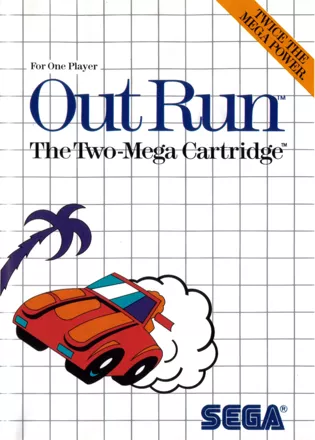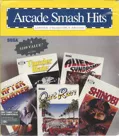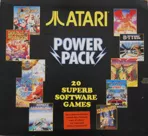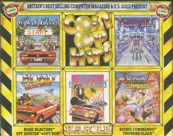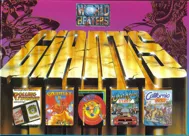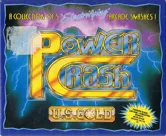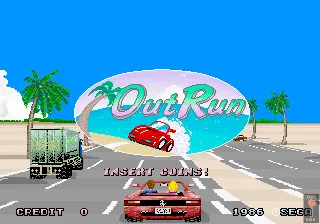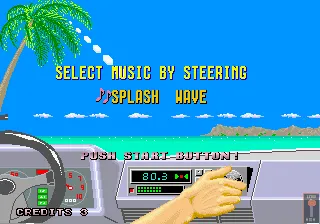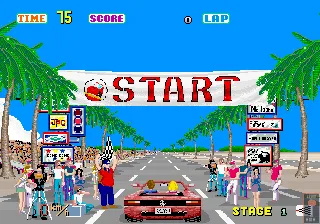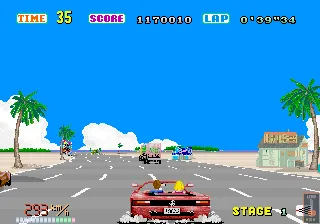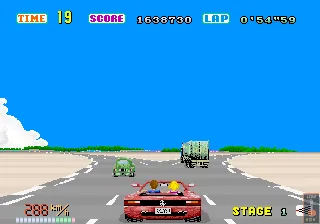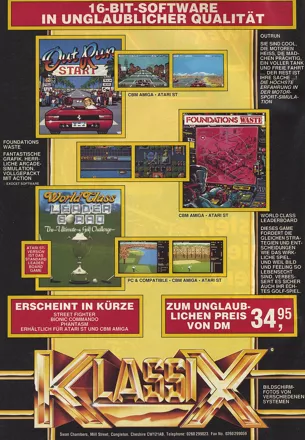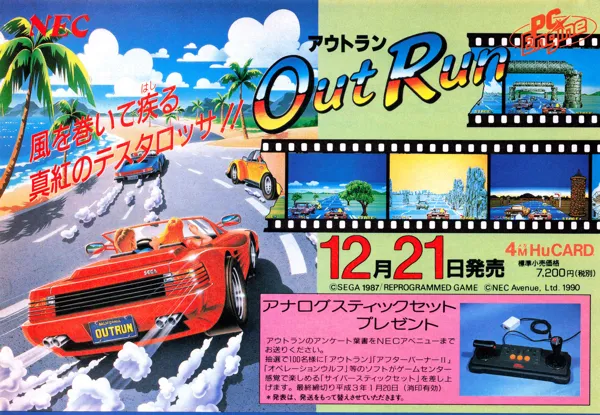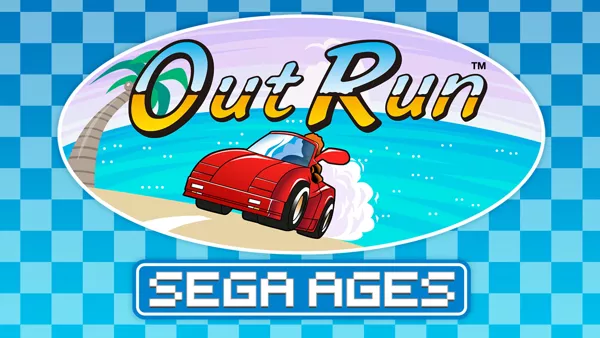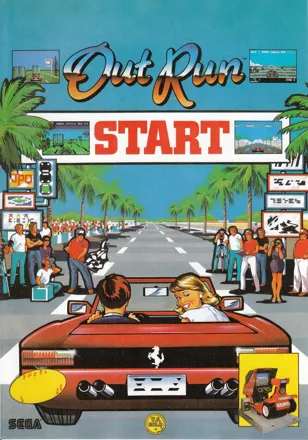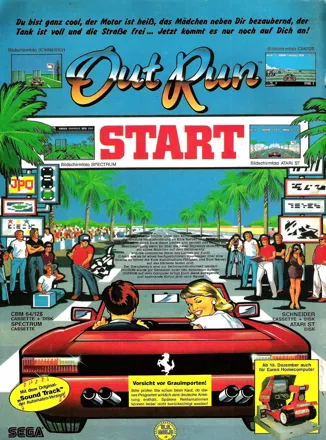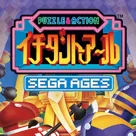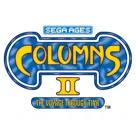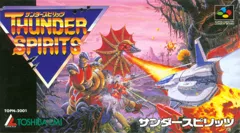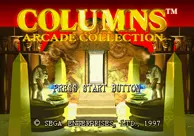OutRun
- OutRun (1990 on Dedicated handheld)
Description official descriptions
OutRun is a racing game that allows the player to race across varied terrain in a readily available Ferrari, complete with a female passenger, over a series of short tracks.
Gameplay is viewed from just above and behind the car. The roads are full of sharp bends and hazards, contact with which can cause the car to roll and lose the player's time. On each section of track there is a fork in the road, allowing the player to choose which direction he or she wishes to go. The player has to to complete five track sections in total, out of the fifteen in the game.
Spellings
- SEGA AGES アウトラン - Japanese Nintendo Switch spelling
- アウトラン - Japanese spelling
Groups +
Screenshots
Promos
Videos
See any errors or missing info for this game?
You can submit a correction, contribute trivia, add to a game group, add a related site or alternate title.
Credits (Arcade version)
8 People
| Best Outrunners |
|
| US Product Manager |
|
Reviews
Critics
Average score: 73% (based on 71 ratings)
| Critic [ Expand All ] | Platform | Score |
|---|---|---|
| Video Game Critic, The | Genesis | 100% |
| SEGAbits | Nintendo 3DS | 100% |
| NintendoWorldReport | Nintendo 3DS | 95% |
| Retro Gamer | Nintendo 3DS | 92% |
| Gaming Age | Nintendo Switch | 91% |
| NintendoWorldReport | Nintendo Switch | 90% |
| SEGA-Portal.de | Genesis | 90% |
| OK Consolas | Game Gear | 90% |
| Nintendo Life | Nintendo Switch | 90% |
| Atari ST User | Atari ST | 90% |
| Nintendo Life | Nintendo 3DS | 90% |
| Commodore User | Arcade | 90% |
| NintendoWorldReport | Nintendo 3DS | 90% |
| Sega-16.com | Genesis | 90% |
| Retro Gamer | Nintendo Switch | 88% |
| Génération 4 | TurboGrafx-16 | 88% |
| ACE (Advanced Computer Entertainment) | Atari ST | 87% |
| 1UP! (France) | SEGA Master System | 87% |
| ACE (Advanced Computer Entertainment) | SEGA Master System | 85% |
| Tilt | SEGA Master System | 85% |
| Retro Archives | Arcade | 85% |
| Retro Archives | SEGA Saturn | 85% |
| ST Action | Atari ST | 84% |
| PC Engine Gamer | TurboGrafx-16 | 83% |
| ACE (Advanced Computer Entertainment) | Amiga | 82% |
| Génération 4 | SEGA Master System | 82% |
| Consolemania | Game Gear | 82% |
| Retro Game Reviews | Game Gear | 80% |
| Mega Console | SEGA Saturn | 80% |
| All Game Guide | Arcade | 80% |
[ 103 More ]
Players
Average score: 3.6 out of 5 (based on 206 ratings with 9 reviews)
A faithful conversion of the popular arcade racing game.
The Good
The arcade game is well known: You race a Ferarri against time to reach one of five possible finishes at the end of a race. There are plenty of scenery changes and a choice of music to keep it entertaining. The PC conversion is faithful to the gameplay, with acceleration and cornering comparible to the performance of the original arcade game.
The Bad
The main things that made the original 1986 arcade game so fun to play were the sights and sounds--a choice of music, colorful scenery, etc. The PC version does as best as it can, but unless you have a Tandy, the experience is lacking. Also, the arcade version had a variable-steering driving wheel, whereas the PC version uses hard-right, hard-left turning, even with a joystick.
The Bottom Line
If you liked the arcade version, you'll like the PC version.
2 of 2 Moby users rated this review helpful.
Did you find this review helpful?
DOS · by Trixter (8946) · 1999
Better than the Arcade Coin Op!!!
The Good
I have a unique take on Out Run for the Sega Master System, as I am one of the few people that actually OWNS the original arcade coin up machine that has a steering wheel (bought it on ebay for $250!!!)
I am not lying to anybody, I enjoyed the Sega Master System's version more than the arcade version! Even though the arcade is always the gold standard, I actually PREFERRED the brighter colors and more realistic driving feel of the SMS over the arcade!
There are an additional two factors that make the SMS superior to the arcade:
1) The OutRun coin op I bought has a serious steering wheel alignment problem! Thus the car lists to the right, making even the first level nearly impossible to win. With the simple SMS keypad (my favorite keypad of all time due to its simplicity and reliability), there are no such problems.
2) No fan noise. The Out Run coin up has a very loud fan that keeps the inner components cool. Yet this translates to very loud and aggravating fan noise, despite the quality of the game. The SMS has no such noise, but the programmers really nailed the right level of road noise!
I'll be fixing my Out Run coin up at some point (new CRT, reduce the fan motor noise, fix the steering wheel), likely for more than I paid for the machine itself! Still, I miss my SMS version because my brother has the console and I don't. Even after getting my cabinet repaired, I'd play my SMS Out Run at least as much if I could get my hands on it.
The Bad
I liked EVERYTHING about this game. Flawless
The Bottom Line
SMS Outrun is BETTER THAN THE ARCADE COIN UP!
5 of 10 Moby users rated this review helpful.
Did you find this review helpful?
SEGA Master System · by Kevin Huang (8) · 2012
The Good
Outrun is a very special game to me for it marked the beginning of high speed racing games, but for the Atari ST version like the Amiga version, since they are identical I don't have anything positive to say about this most appalling piece of programming in the history of software.
The Bad
This is just not outrun, all the fond memories u may have had playing the father of racing games in the arcades will be shattered and lost for ever if u ever play this version. First of all you are greeted with an impressive title screen, makes u think wow this is going to be good, apart from the amiga version where it plays the most appalling rendition of bolted together samples of the orchestra of doom which has nothing to do with outrun anyway, after the title screen you are presented with the game, WITH PULL DOWN MENUS, I have never played a racing game with pull down menus, it really makes the game look cheap and nasty, then you have the main graphics, at first glance I really thought this was the commodore 64 version for the graphics are as blocky as hell, the frame rate is just useless, you jump at like 10 feet at a time, with probably an average of about 5 frames per second, then you have the passengers swapping seats, yes swapping seats, when u turn the car the man and the woman swap sides, the sound is comparable to a zx spectrum 48k with no thought of taking advantage of the sound capabilities. This type of shoddy workmanship just proves it was just another rushed crappy conversion to grab a quick buck on a new format yet again. It is such a shame, the ST and especially the amiga version could have been so much better, considering the Amiga actually used the same 68000 processor that the ORIGINAL arcade had as well, there was no excuse for this mess.
The Bottom Line
Look elsewhere, avoid like the plague.
2 of 3 Moby users rated this review helpful.
Did you find this review helpful?
Atari ST · by Stephen N (11) · 2004
Discussion
| Subject | By | Date |
|---|---|---|
| Outrun on Amstrad GX4000 | Robert Francis | Jul 17, 2011 |
Trivia
1001 Video Games
OutRun appears in the book 1001 Video Games You Must Play Before You Die by General Editor Tony Mott.
Car
The classic red racer you use in the game is quite obviously a convertible Ferrari Testarossa (right down to the "Cavallino Rampante" logo featured in the back of the car), however SEGA had not licensed the likeness of Ferrari products and got into a series of legal issues with Ferrari. The eventually settled but it wouldn't be until OutRun 2 that the car would become an "official" Ferrari.
Copyright infringement
There was a patent case over the DOS port by Unlimited Software, the porting division of Distinctive Software. Accolade, for whom Distinctive had written The Duel: Test Drive II sought a preliminary injunction against Distinctive Software. It did not deal with the general look of the game, but rather the underlying source code.
Distinctive used some of the underlying "computer code" from The Duel for the OutRun DOS port, which Accolade challenged as an infringement of their copyright. Distinctive argued that these were standard libraries and routines, re-used in different games only for the sake of not having to reprogram them. Also, they claimed Accolade never contemplated the transfer of copyright in the library codes and, even if it did, the codes were not subject to copyright protection in the first place.
Ultimately, Accolade lost the case because the licensing agreement only referred to the concept and design of the game, but not the underlying codes.
The full case can be read through a link in the related links section.
Extras
A special edition of Outrun on cassette for Commodore 64 was bundled with a cassette containing the music from the original arcade game. The intention being to be listened to while playing the game!
Game Art Beyond
In 2018, Out Run was selected as one of the biggest classics on the Commodore 64 by the creators of the C64 graphics collection Game Art Beyond. Out Run was honoured with a high resolution title picture (based on the Amiga title screen artwork) in a special C64 graphics format called NUFLI, along with a new C64 SID interpretation of the famous Splash Wave theme. After listening to it completely, a short version of Passing Breeze can also be heard - this tune was missing in the original C64 conversion.
Tandy
The PC version has undocumented support for the Tandy TL/RL/SL series; there are a few digitized sound samples that can be heard if the joystick is not chosen to play the game (since the TL/RL/SL couldn't play digitized sound and access the joystick at the same time, due to a rediculous design flaw).
MSX versions
Two versions of the game exist for MSX computers. The first one is for MSX1 computers, was developed by US Gold and is nearly identical to the other 8 bit versions of the game. It was likely released in both tape and disk formats. The second one was developed by Pony Canyon for MSX2 computers and had improved graphics and speed. It was likely released in Japan and in cartridge format only, although pirated disk versions do exist.
Technology
Second game Sega made in the 80's that used "Super Scaler" technology.
Differences between The Japanese and Over Seas versions
There are some differences between The Japanese and Over Seas versions of the game in terms of arrangement of courses. The famous Rock Tunnel stage is an entirely different in the Over Seas version as well as it appears much sooner in the game. Only Mega Drive edition of "Outrun" includes both options to play different versions.
Commodore 64 version
In C64 version "Passing Breeze" tune is replaced with "Radio Off" option.
Awards
- Retro Gamer
- October 2004 (Issue #9) – #44 Best Game Of All Time (Readers' Vote)
Information also contributed by Garcia, Robbb, Sciere and Zovni
Analytics
Related Sites +
- Patent Case: Accolade v. Distinctive
A description of the patent case between Accolade and Distinctive over the DOS port - The Sega Out Run FAQ
Lots of information can be found in this guide by Chris White.
Identifiers +
Contribute
Are you familiar with this game? Help document and preserve this entry in video game history! If your contribution is approved, you will earn points and be credited as a contributor.
Contributors to this Entry
Game added by Trixter.
Nintendo 3DS added by Michael Cassidy. SEGA Master System added by Tibes80. Nintendo Switch added by Rik Hideto. J2ME added by chirinea. Arcade added by FatherJack. Amstrad CPC added by Zovni. Amiga added by Martin Smith. ZX Spectrum added by Terok Nor. Game Gear added by Macintrash. Atari ST, Commodore 64 added by Servo. SEGA Saturn added by Игги Друге. MSX added by koffiepad. TurboGrafx-16 added by Katakis | カタキス. Genesis added by Syed GJ.
Additional contributors: Jeanne, chirinea, Sciere, Kabushi, Martin Smith, Freeman, Neville, Patrick Bregger, mailmanppa, Rik Hideto, Malte Mundt, Harmony♡, joicrawu.
Game added March 1, 1999. Last modified January 5, 2025.


